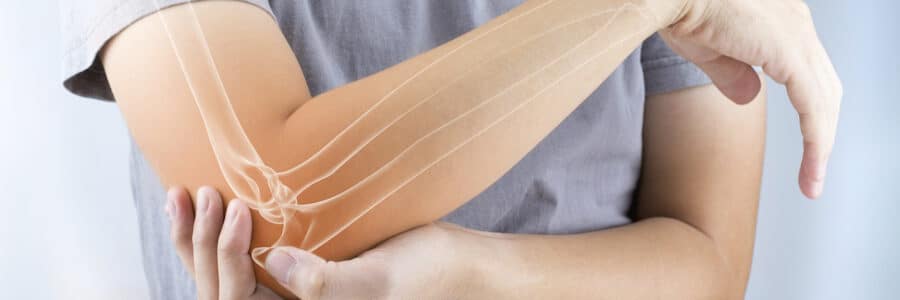The ulnar nerve, known in medical jargon as nervus ulnaris, ensures that you can, for example, grab objects and unlock the door easily. However, if this is narrowed, numbness and pain in the area of the little and ring fingers can occur. We refer to this as the sulcus-nervi-ulnaris syndrome, which is also known as the ulnar groove syndrome. Below you will find out which treatment options are available and what you should pay attention to in this context.
What are the symptoms of ulnar sulcus nerve syndrome?
Sulcus-nervi-ulnaris syndrome, also known as ulnar groove syndrome, is a narrowing of the ulnar nerve (= ulnar nerve). This runs on the inside of the elbow in a well palpable groove and supplies half the ring and little finger with motor and sensitivity.
In the early stages of the disease, the sulcus-nervi-ulnaris syndrome manifests itself through tingling paresthesia (“pins and needles”), numbness and pain in the area of the little and ring fingers. In addition, a reduction in strength in the hand on the affected side and clumsiness or weakness of the hand are possible. Ultimately, this leads to dropping objects more easily or that simple actions such as unlocking your apartment door are difficult or impossible to do at all. Many patients report that they experience these symptoms more intensely at night and in the early morning, as well as when they rest on their elbows. In the later stages of the syndrome, sensory disturbances may persist. In addition, it is possible that a so-called “claw hand” forms, in which those affected can no longer straighten their little and ring fingers. In addition, increasing muscle wasting in the finger and hand area with a resulting loss of strength and pain in the elbow, forearm and palm area are typical.
What are the causes of the sulcus-nervi-ulnaris syndrome?
The ulnar nerve has to pass several possible constrictions in its course from the spinal cord to the hand. Since the elbow nerve runs on the inside of the elbow through an approximately three to four centimeter long bony groove (= sulcus nervi ulnaris), a pressure point most often develops precisely at this point. In addition, there is a strong band in the bone groove, which completes the groove on its open side to form a canal. Since the ulnar nerve lies directly under the skin with only a small amount of connective tissue, the ligament can narrow it if necessary. Over time, this can lead to impaired blood flow. Because of this, the ulnar nerve is particularly vulnerable to traction and pressure injuries. Constant strain or repetitive movements can irritate and ultimately damage it.
When does an operation make sense in the case of an ulnar groove syndrome?
In the case of slight restrictions, it is usually sufficient to relieve the pressure on the nerve. A supporting cuff in the area of the elbow joint may be advisable for this. If the disease is already at an advanced stage, however, surgical relief of the nerve is usually necessary. If you experience pain in your hand or even symptoms of paralysis occur, the sulcus-nervi-ulnaris syndrome can be treated with open or endoscopic surgery.

What do I have to consider before the operation for sulcus-nervi-ulnaris syndrome?
A detailed consultation with Dr. Matiasek, in which he examines you thoroughly and informs you about the treatment options for sulcus-nervi-ulnaris syndrome. In this conversation you have the time to ask all your questions and to find out about the appropriate pre- and post-operative care. You should stop taking blood-thinning medication, such as aspirin, at least one week before the procedure, as these could otherwise lead to an increased tendency to bleed during the course of the operation and afterwards. It is also important that you arrive on an empty stomach for the surgery. Dr. Matiasek will also inform you about possible complications and risks so that you feel fully prepared for the procedure.
How does the operation work in the case of the ulnar groove syndrome?
The procedure takes place in an inpatient setting and under general anesthesia. There are two methods of operating – in principle, the pinched nerve is either released from its constriction or completely relocated so that the problem no longer occurs in the future. At the beginning, Dr. Matiasek makes an incision on the inside of the elbow joint. Depending on which technique is most suitable, this incision is a few centimeters up to 15 centimeters. Then the constrictions of the nerve are examined more closely in order to assess whether the ulnar nerve can remain in its natural position. This depends primarily on whether it remains in its bony groove when moving the elbow joint. If this is not the case, the nerve must be relocated forward under the forearm muscles or in soft fatty tissue in order to be able to guarantee optimal padding. Then Dr. Matiasek provides drainage so that the wound secretion can be drained away.
At the end of the operation, the patient’s skin is closed with fine cosmetic sutures and the elbow joint is connected. In doing so, Dr. Matiasek offers a lightweight plastic splint so that your arm can stay still in the weeks that follow.
During the course of the procedure and after waking up from anesthesia, Dr. Matiasek will discuss the further postoperative process with you and issue a medication prescription. You can also arrange a first appointment for operative follow-up care, which involves a change of dressing.
What complications can occur during sulcus nervi ulnaris surgery?
After the surgery, small bruises and swellings can occur, but these usually subside quickly through active movement or after loosening the bandage. If the wound is more swollen, in addition to loosening the bandage, you should also use ice packs several times a day, but you must ensure that the wound does not get wet.
The infection rate is very low, but you should pay attention to the first signs of infection – such as severe swelling, restricted mobility, throbbing pain in the operating area, reddening or even drainage of pus from the wound – and if necessary, go to the clinic immediately to find the right treatment can be initiated.
Other complications that can occur, but which are very rare, are injuries to the ulnar nerve during the operation and the occurrence of reflex sympathetic dystrophy. By this we mean a complex regional pain syndrome in which there is persistent pain in the area of the wound after an operation or an injury.
What do I have to watch out for after the ulnar groove syndrome surgery?
After the operation, you should take care of your arm and wear a supportive plastic splint for at least three weeks, which should not get wet. The best way to avoid swelling of the hand and arm is to keep the arm on the upper body for the first few days after the operation. It is possible to move the elbow slightly from the first postoperative day, but you should do this with great care. The sutures will be removed after seven to ten days, and you can wash your arm normally again from the following day. In the third week after the operation, you can usually start with movement exercises from the splint. In addition, you should avoid excessive flexion of the elbow for a long period of time (for example, when resting on a desk) in order to protect the ulnar nerve.
What is the prognosis for a sulcus-nervi-ulnaris syndrome?
Since there are good treatment options for sulcus nervi ulnaris syndrome, the prognosis is correspondingly good. However, it should be noted that the recovery of the elbow nerve is extremely tedious due to the long regeneration distance from the elbow to the fingers. The regression of the sensory disturbances can take up to a year. If there was also muscle wasting before the operation, the improvement in strength is often incomplete. Re-entrapment of the ulnar nerve is very rare, as most of those affected are careful and carefully avoid pressure on the nerve in the surgical area in the future.
A sulcus-nervi-ulnaris syndrome is a painful disease, but it can be combated almost without any problems in just a few steps. With his in-depth knowledge and professional treatment options, Dr. Matiasek will offer you a customized and successful therapy.






